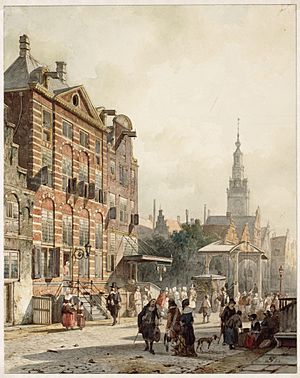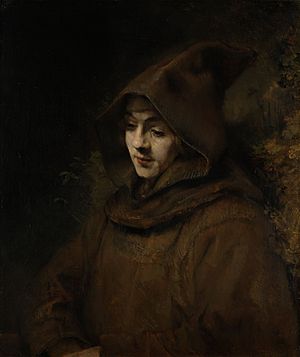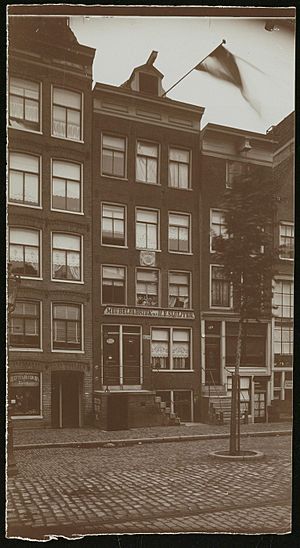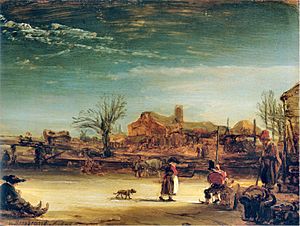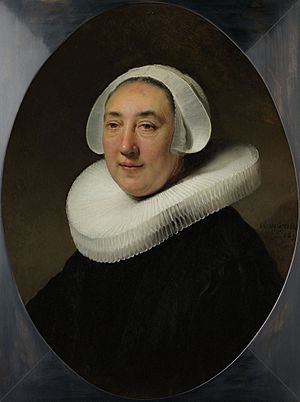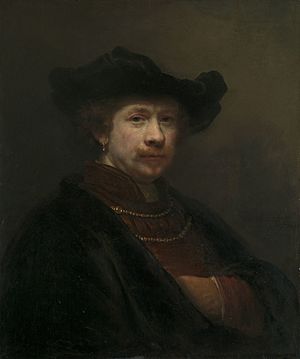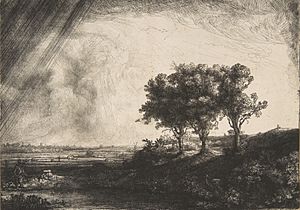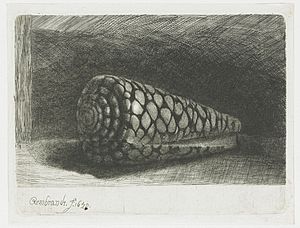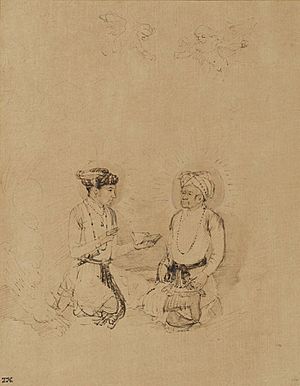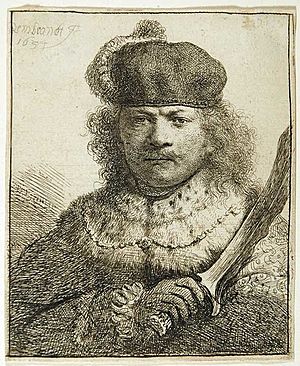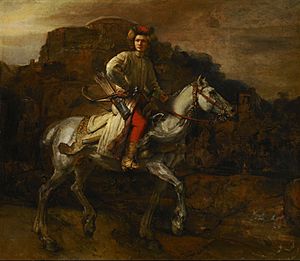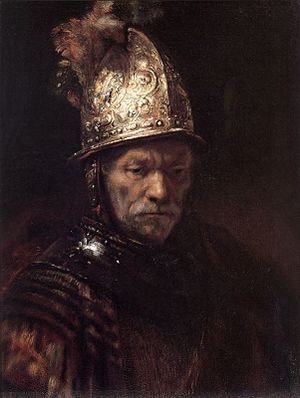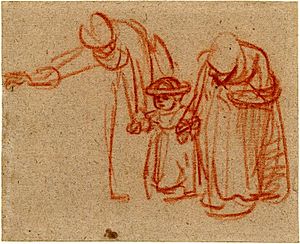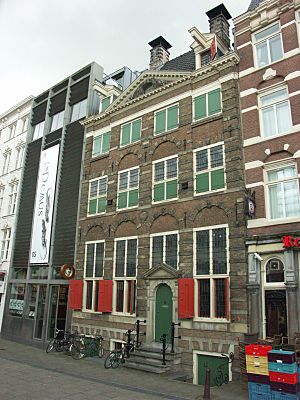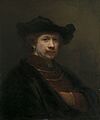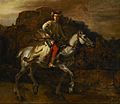Rembrandt facts for kids
Quick facts for kids
Rembrandt
|
|
|---|---|
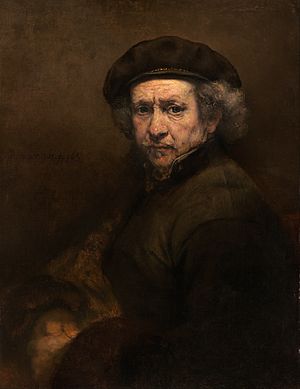
Rembrandt as depicted in his 1659 Self-Portrait with Beret and Turned-Up Collar (now housed in the National Gallery of Art in Washington, D.C.)
|
|
| Born |
Rembrandt Harmenszoon van Rijn
15 July 1606 |
| Died | 4 October 1669 (aged 63) Amsterdam, Dutch Republic
|
| Education | Jacob van Swanenburg Pieter Lastman |
| Known for | Painting, printmaking, drawing |
|
Notable work
|
Self-portraits The Anatomy Lesson of Dr. Nicolaes Tulp (1632) Belshazzar's Feast (1635) The Night Watch (1642) Bathsheba at Her Bath (1654) Syndics of the Drapers' Guild (1662) The Hundred Guilder Print (etching, c. 1647–1649) |
| Movement | Dutch Golden Age Baroque |
Rembrandt Harmenszoon van Rijn (15 July 1606 – 4 October 1669), known simply as Rembrandt, was a famous Dutch Golden Age artist. He was a painter, printmaker, and draughtsman. Many people consider him one of the greatest visual artists in history. He is also the most important artist in Dutch art history.
Rembrandt created about 300 paintings, 300 etchings, and 2,000 drawings. Unlike many artists of his time, his works showed many different styles and subjects. He painted portraits, self-portraits, landscapes, and scenes from everyday life. He also painted stories from the Bible and myths.
His art was made during a time of great success in the Netherlands, called the Dutch Golden Age. Dutch art was very creative and new during this period. Rembrandt was also an art collector and art dealer, like many artists then.
Rembrandt never traveled outside the Netherlands. But he was inspired by Italian masters and Dutch artists who had studied in Italy. These included Pieter Lastman and Peter Paul Rubens. Even though he faced personal problems and money troubles later in life, his art was always popular. He also taught many important Dutch painters for twenty years.
Rembrandt's portraits of people he knew, his self-portraits, and his Bible scenes are considered his best works. His 40 self-portraits are like a personal diary. He also changed etching from a simple copying method into a true art form. His reputation as a great etcher was known even when he was alive. While few of his paintings left the Netherlands, his prints were shared all over Europe.
His art shows he knew a lot about classical iconography (the meaning of symbols in art). When he painted a Bible scene, he used his knowledge of the text. He also used classical art styles and observed the Jewish people in Amsterdam. People have called him "one of the great prophets of civilization" because he showed so much understanding for people. The French sculptor Auguste Rodin once said that no one should ever be compared to Rembrandt.
Contents
Early Life and Art Training
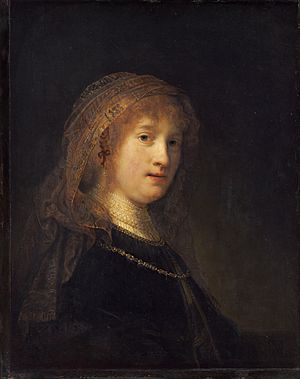
Rembrandt Harmenszoon van Rijn was born on July 15, 1606, in Leiden, which is now in the Netherlands. He was the ninth child in his family. His family was quite well-off; his father was a miller and his mother was a baker's daughter. Religion was important in Rembrandt's art. His mother was Catholic, and his father belonged to the Dutch Reformed Church.
As a boy, he went to a Latin school. At 13, he started at the University of Leiden. But he was more interested in painting. He soon became a student of Jacob van Swanenburg for three years. After that, he studied with the history painter Pieter Lastman in Amsterdam for six months. He then started his own art studio. Unlike many artists of his time, Rembrandt never left the Netherlands to study art in Italy.
Rembrandt's Career
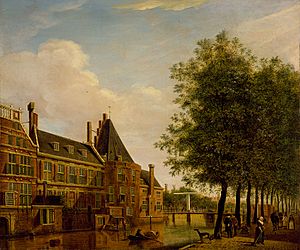
Around 1624 or 1625, Rembrandt opened an art studio in Leiden with his friend Jan Lievens. By 1627, he started taking in students, including Gerrit Dou.
In 1629, a statesman named Constantijn Huygens discovered Rembrandt. Huygens helped Rembrandt get important jobs from the court in The Hague. Because of this, Prince Frederik Hendrik bought paintings from Rembrandt until 1646.
In late 1631, Rembrandt moved to Amsterdam. This city was growing fast as a center for business and trade. He became a professional portrait painter and was very successful. He first stayed with an art dealer, Hendrick van Uylenburgh. In 1634, he married Hendrick's cousin, Saskia van Uylenburgh. Saskia came from a respected family. Her father was a lawyer and a mayor. They married in a local church without Rembrandt's family present. That same year, Rembrandt became a citizen of Amsterdam and joined the local guild of painters. He also took on more students, like Ferdinand Bol and Govert Flinck.
In 1635, Rembrandt and Saskia rented a nice home with a view of the river. In 1639, they moved to a large, modern house in a fancy area called 'Breestraat'. Many artists and art dealers lived there. The neighborhood also had many immigrants and was becoming the Jewish quarter. Rembrandt often asked his Jewish neighbors to pose for his paintings of Old Testament scenes.
Rembrandt and Saskia faced sad times. Their first son and two daughters died very young. Only their fourth child, Titus, born in 1641, lived to be an adult. Saskia died in 1642, probably from tuberculosis. Rembrandt's drawings of her when she was sick and dying are very touching.
Later, Rembrandt had a daughter named Cornelia with Hendrickje Stoffels, who had been his maid. He did not marry Hendrickje. If he had remarried, he would have lost money set aside for Titus in Saskia's will.
Financial Challenges
Rembrandt spent a lot of money on art, prints, and rare items. This led to financial problems. In 1656, he declared that he could not pay his debts. He had to give up his belongings. The authorities and his creditors were understanding and gave him time to pay. In 1657, an auction was held to sell his paintings, etchings, and drawings. He was allowed to keep his art tools, including his etching press, to earn money.
The list of items sold showed Rembrandt's large collection. It included old master paintings, statues, books, armor, and objects from Asia. The prices from the sale were not as high as hoped. In 1658, Rembrandt's house was sold. His family moved to a smaller home.
To help him, Hendrickje and Titus started a business as art dealers. This allowed Rembrandt to keep making art. In 1661, he was hired to paint for the new town hall. However, his painting, The Conspiracy of Claudius Civilis, was rejected. He continued to get important portrait jobs, like Syndics of the Drapers' Guild in 1662. Around this time, he took on his last student, Aert de Gelder.
Rembrandt lived longer than both Hendrickje and Titus. Titus died in 1668, leaving behind a pregnant wife. Rembrandt died on October 4, 1669. He was buried in the Westerkerk. His only grandchild, Titia, inherited a good amount of money from Titus. Rembrandt had many legal and financial challenges throughout his life.
Rembrandt's Famous Works
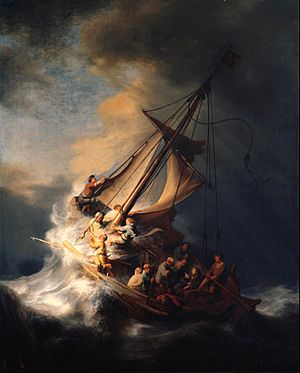
Rembrandt once wrote that he wanted his art to show "the greatest and most natural movement." This might mean he wanted to show strong emotions. Critics often note how Rembrandt combined everyday life with spiritual themes in his art.
In the past, people thought Rembrandt painted over 600 paintings. But newer studies, like those by the Rembrandt Research Project, suggest he painted closer to 300. His prints (etchings) are about 300. He likely made more than 2,000 drawings, but fewer have survived.
About 90 paintings were once thought to be Rembrandt self-portraits. But we now know he had his students copy his self-portraits as practice. Modern experts believe he painted over 40 self-portraits, plus some drawings and etchings. These self-portraits show his journey from a young man to a successful artist, and then to an older, thoughtful man. They give us a clear picture of him and his feelings.
In his portraits, Rembrandt often angled the face so that the nose divided light and shadow. This made the nose stand out and focused attention on the contrast between bright light and deep shadows.
In some Bible paintings, like The Raising of the Cross, Rembrandt painted himself as one of the people in the crowd. Some believe this is because the Bible was like a diary for him, showing moments from his own life.
Rembrandt's art is known for his use of chiaroscuro. This is a dramatic use of light and shadow, inspired by artists like Caravaggio. He also showed his subjects in a lively way, without the stiff poses common at the time. He had deep sympathy for people, no matter their wealth or age. His family, including his wife Saskia, his son Titus, and Hendrickje, often appeared in his paintings. Many of these paintings had mythical, biblical, or historical themes.
Artistic Periods and Styles
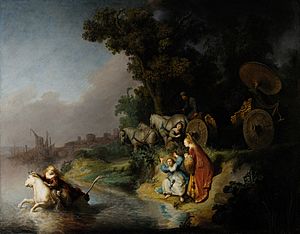
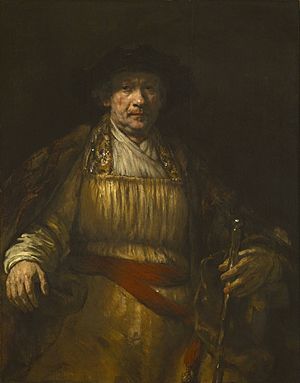
Throughout his career, Rembrandt mainly painted portraits, landscapes, and story paintings. People praised him for how well he told Bible stories. He was good at showing emotions and details. His painting style changed over time. Early on, his paintings were "smooth" with fine details. Later, he used a "rougher" style with thick paint, which made the forms look real.
His skill as a printmaker also grew. In his later etchings, he showed the same freedom as in his drawings and paintings. His prints covered many subjects and techniques. Sometimes he left large white areas to show space. Other times, he used many lines to create dark tones.
Lastman's influence was strongest on Rembrandt from 1625 to 1631. His paintings were small but full of details, like costumes and jewelry. He liked religious and allegorical themes. In 1626, Rembrandt made his first etchings. These helped spread his fame around the world. In 1629, he painted Judas Repentant, Returning the Pieces of Silver and The Artist in His Studio. These works show his interest in light and different ways to apply paint.
In his early years in Amsterdam (1632–1636), Rembrandt painted dramatic Bible and myth scenes. These were large and had strong contrasts of light and dark. He wanted to be like the Baroque artist Peter Paul Rubens. With help from assistants, he painted many portraits, both small and large. These included Anatomy Lesson of Dr. Nicolaes Tulp (1632).
By the late 1630s, Rembrandt had painted and etched many landscapes. These often showed dramatic nature, like uprooted trees and stormy skies. After 1640, his work became calmer, perhaps because of personal sadness. He painted more scenes from the New Testament than the Old Testament. In 1642, he painted The Night Watch. This was his most important group portrait from this time.
In the years after The Night Watch, Rembrandt's paintings varied a lot in size, subject, and style. He moved from strong light and shadow contrasts to using more direct light and brighter colors. His figures also appeared more directly facing the viewer. These changes might show his interest in classical art. His use of brushstrokes also became more expressive.
In the 1650s, Rembrandt's style changed again. Colors became richer, and brush strokes were more noticeable. He moved away from the popular detailed styles of the time. His use of light became sharper, and shiny effects were rare. He applied paint in a unique, thick way. People sometimes criticized his rough brushwork. He even told visitors not to look too closely at his paintings.
In his last years, Rembrandt often painted biblical themes. But he focused on single figures rather than large groups. He painted his most thoughtful self-portraits from 1652 to 1669. He also created touching images of men and women, like The Jewish Bride (around 1666).
Prints and Drawings
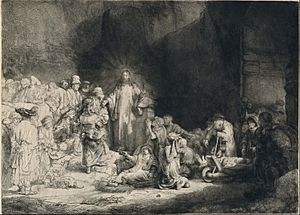
Rembrandt made etchings for most of his career, from 1626 to 1660. He was very involved in the whole process of making prints. He often printed the first copies of his etchings himself. At first, his etching style was like drawing. But soon, he used many lines and acid treatments to create different line strengths. Later, he used a simpler style with fewer acid treatments. He worked on the famous Hundred Guilder Print in stages during the 1640s. This was a very important work in his career.
In his later works from the 1650s, Rembrandt often changed his etchings as he worked. Large prints often exist in many different versions. He used hatching (parallel lines) to create dark areas. He also tried printing on different types of paper, including Japanese paper and vellum. He would sometimes leave a thin layer of ink on the plate to create special effects. He also used drypoint, which creates a soft, fuzzy line.
His prints have similar subjects to his paintings. He made 27 self-portrait prints. He also made 46 landscapes, mostly small. These landscapes influenced how graphic artists drew landscapes for a long time. One-third of his etchings are religious subjects. Many are simple, while others are very grand. Rembrandt owned a large collection of prints by other artists. He was influenced by artists like Andrea Mantegna, Raphael, and Hercules Seghers.
Rembrandt's drawings have been studied by many experts. His drawing style was unique. It was described as a mix of clear shapes and lively lines, similar to Chinese painting.
Asian Art Inspiration
Rembrandt was interested in Mughal miniatures, especially around the 1650s. He drew his own versions of about 23 Mughal paintings. He might have owned a collection of them. These miniatures included paintings of Indian emperors like Shah Jahan and Akbar. They may have influenced the costumes and other details in Rembrandt's own works.
The Night Watch
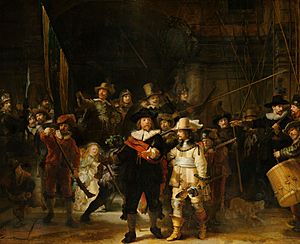
Rembrandt painted The Militia Company of Captain Frans Banning Cocq between 1640 and 1642. This became his most famous work. The Dutch called it De Nachtwacht, and Sir Joshua Reynolds called it The Night Watch. By 1781, the painting was so dark that it looked like a night scene. But after it was cleaned, people saw that it showed a daytime scene. It shows 18 musketeers stepping from a dark courtyard into bright sunlight.
The painting was ordered for the new hall of the Kloveniersdoelen, which was a building for the city's militia. Rembrandt did not paint a typical formal group portrait. Instead, he showed the militia getting ready for a mission. The exact nature of this mission is still debated.
Many people think the painting was not liked at first, but it was actually a success from the beginning. Parts of the canvas were cut off later (about 20% from the left side). This was done so the painting would fit its new spot in the Amsterdam town hall in 1715. Since 1885, the painting has been displayed at the Rijksmuseum. During World War II, it was moved to different safe places to protect it.
Expert Opinions on Rembrandt's Art
In 1968, the Rembrandt Research Project began. Art historians and other experts worked together to check if works truly were by Rembrandt. They used new scientific methods. As a result, many paintings once thought to be by Rembrandt were removed from his list. Many of these are now believed to be by his students. However, some paintings have also been added back to his list.
One example is The Polish Rider, which is in the Frick Collection in New York City. For many years, most experts agreed it was by Rembrandt. But in the 1980s, one scholar suggested it might be by one of Rembrandt's students, Willem Drost. However, this idea is now mostly rejected, and the Frick Collection still says it is by Rembrandt. More recent opinions strongly support it being by Rembrandt.
Another debate is about the subject of Aristotle with a Bust of Homer. Some experts now believe it shows the ancient Greek painter Apelles instead of Aristotle.
The painting Pilate Washing His Hands is also debated. Some scholars think it was painted by an unknown student, possibly Aert de Gelder, in the 1660s. It looks a bit like Rembrandt's later works, but it doesn't have his strong control of light and form.
The work of checking and re-checking Rembrandt's paintings is still going on. In 2005, four oil paintings that were thought to be by his students were reclassified as Rembrandt's own work. These included Study of an Old Man in Profile and Study of an Old Man with a Beard.
It is hard to be sure about Rembrandt's paintings because of how he ran his studio. Like many masters, he encouraged his students to copy his works. Sometimes he would finish or touch up their copies to sell them as originals. Also, his most talented students could copy his style very well. Adding to the confusion, some of Rembrandt's own work varies in quality, and he often changed his style. Later copies and damaged restorations also make it difficult. It is likely that experts will never fully agree on every single painting by Rembrandt.
Rembrandt's Name and Signature
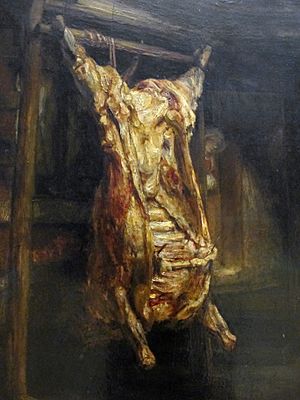
The name "Rembrandt" is how the artist changed the spelling of his first name in 1633. "Harmenszoon" means "son of Harmen," which was his father's name. "van Rijn" means his family lived near the Rhine river.
Rembrandt's first signatures (around 1625) were just an "R" or "RH" (for Rembrant Harmenszoon). From 1629, he used "RHL" (the "L" probably stood for Leiden). In 1632, he used "RHL-van Rijn" but then started using only his first name, "Rembrant." In 1633, he added a "d" to make it "Rembrandt." He kept this spelling from then on. This change was just for how it looked; it didn't change how his name was said. Even though he signed his art with "Rembrandt," most documents during his life still used the original "Rembrant" spelling. He probably signed with just his first name, like Raphael, Leonardo da Vinci, and Michelangelo, who were also known by their first names.
Rembrandt's Workshop
Rembrandt had a large workshop and many students. It is hard to know exactly who worked for him because his style influenced so many artists. Many painters copied his style for people who wanted a "Rembrandt." Some of his known students include Ferdinand Bol, Gerrit Dou, Carel Fabritius, and Govert Flinck.
Museum Collections
The best places to see Rembrandt's work are:
- The Rijksmuseum in Amsterdam, which has The Night Watch and The Jewish Bride.
- The Mauritshuis in The Hague.
- The Hermitage Museum in St. Petersburg.
- The National Gallery in London.
- The Gemäldegalerie in Berlin.
- The Louvre in Paris.
In the United States, you can find Rembrandt's paintings at:
- The Metropolitan Museum of Art and Frick Collection in New York City.
- The National Gallery of Art in Washington, D.C.
- The Museum of Fine Arts in Boston.
- The J. Paul Getty Museum in Los Angeles.
The Rembrandt House Museum in Amsterdam is in the house he bought when he was very successful. It has furniture from that time, similar to what Rembrandt might have owned. It also shows paintings that reflect his art dealing business. His printmaking studio has a printing press, where copies of his prints are made. The museum has some of Rembrandt's paintings and a large collection of his prints.
Rembrandt's Influence and Fame
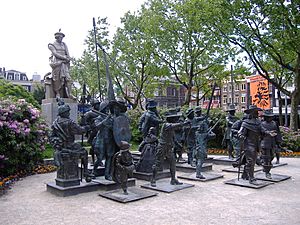
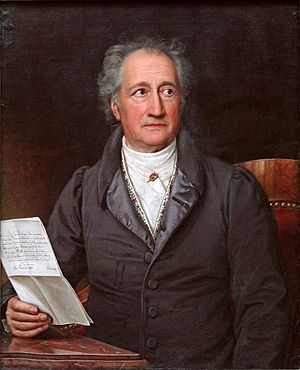
Rembrandt is one of the most famous and studied artists in history. His life and art have interested many different fields, like art history, social studies, and philosophy. He has been the subject of many books and stories. Studying Rembrandt is a field of its own, with many experts.
Francisco Goya, another great artist, said he had three teachers: Nature, Velázquez, and Rembrandt. In the 18th and 19th centuries, people in France, Germany, and Britain rediscovered Rembrandt's art. This helped make him famous for centuries to come. When someone compared his work to Rembrandt's, the sculptor Auguste Rodin said, "Compare me with Rembrandt? What a terrible thing to say! Rembrandt is a giant of Art! We should bow down before Rembrandt and never compare anyone to him!" Vincent van Gogh wrote that Rembrandt "goes so deep into the mysterious that he says things for which there are no words."
Rembrandt and the Jewish Community
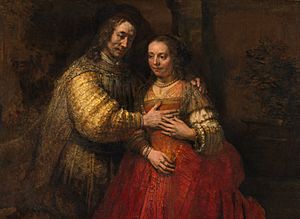
Even though Rembrandt was not Jewish, he had a big impact on many modern Jewish artists and writers. The German-Jewish painter Max Liebermann once said, "Whenever I see a Frans Hals, I feel like painting; whenever I see a Rembrandt, I feel like giving up." This shows how much he admired Rembrandt. Marc Chagall, another artist, felt that Rembrandt understood him.
Images for kids
See also
 In Spanish: Rembrandt para niños
In Spanish: Rembrandt para niños


